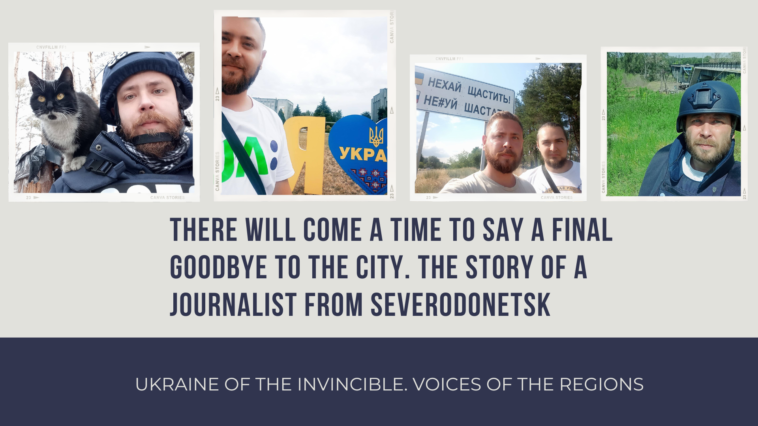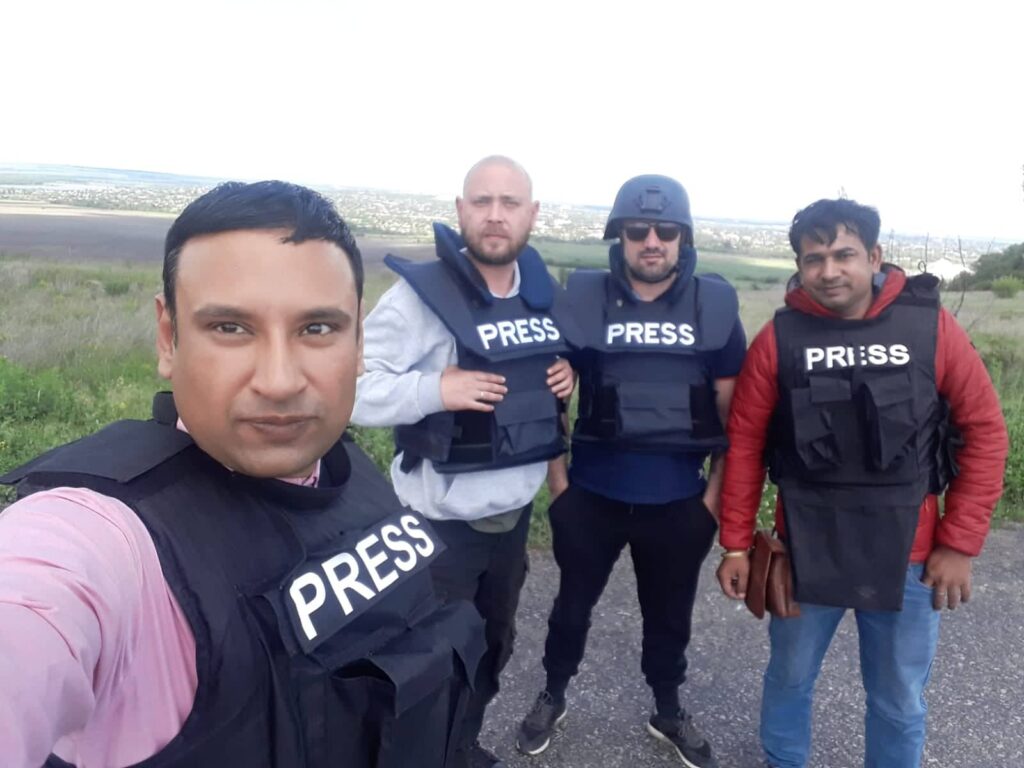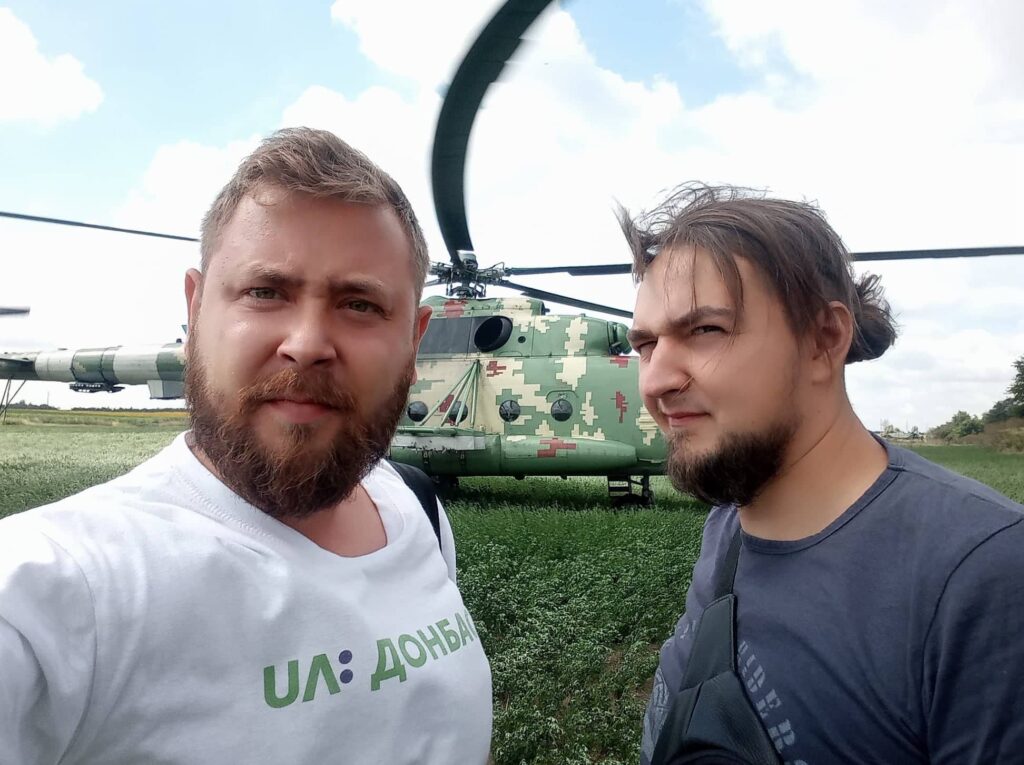“War is no longer made by simply analyzed economic forces if it ever was. War is made or planned now by individual men, demagogues and dictators who play on the patriotism of their people to mislead them into a belief in the great fallacy of war when all their vaunted reforms have failed to satisfy the people they misrule.”
As early as 1935, the prominent American Ernest Hemingway, in an article on the inevitability of a new world war, described modern Russia and what motivated its regime to aggression against Ukraine.
Later, he will report the Spanish Civil War, and his example will once again prove that no one can surpass a journalist in describing the history of modern wars.
This is also true of journalists from the east of Ukraine. Having gained experience in covering the war since 2014, they try to be in the center of events, and leave their professional place only when there is an immediate threat to life.
War began in 2014
Serhiy Okishev is a journalist from Severodonetsk, Luhansk region. In recent years, he worked as a TV presenter and newsman on the city’s leading channels. With the beginning of the all-out Russian invasion, his life, like that of many Ukrainians, changed dramatically. Serhiy took his family to the Dnipropetrovsk region, and continues to work as a war correspondent, only now on the Priamiy TV channel.
“Until February 24, 2022, before Russia’s full-scale invasion of Ukraine, I was a managing editor and also a war correspondent on a local TV channel in Severodonetsk,” Serhiy says.
He shows archival photos and talks about how he visited boys in the trenches in the Luhansk region, how he underwent special training and about his experiences.
“I was also a newsman then – I coordinated the work of local journalists, edited their stories. I went personally to shoot my stories, to the front line in particular. I also hosted evening analytical programs with experts.”
Very often Serhiy went to Stanytsia Luhanska, which is currently under occupation for the second time.
“There were periods when we went to Stanytsia Luhanska two or three times a week. Those were mostly either aggravations or periods of withdrawal and disengagement. There was a period when in Stanytsia Luhanska a destroyed bridge across the Siverskyi Donets was being restored from the Ukrainian side. A lot of politicians of various ranks and civil servants came at that time. Everyone tried, so to say, to appropriate the opening of the bridge. Well, we, as a TV channel focused on this region, the Luhansk and Donetsk regions, covered it all and considered it necessary to convey it, including to the occupied territory.”
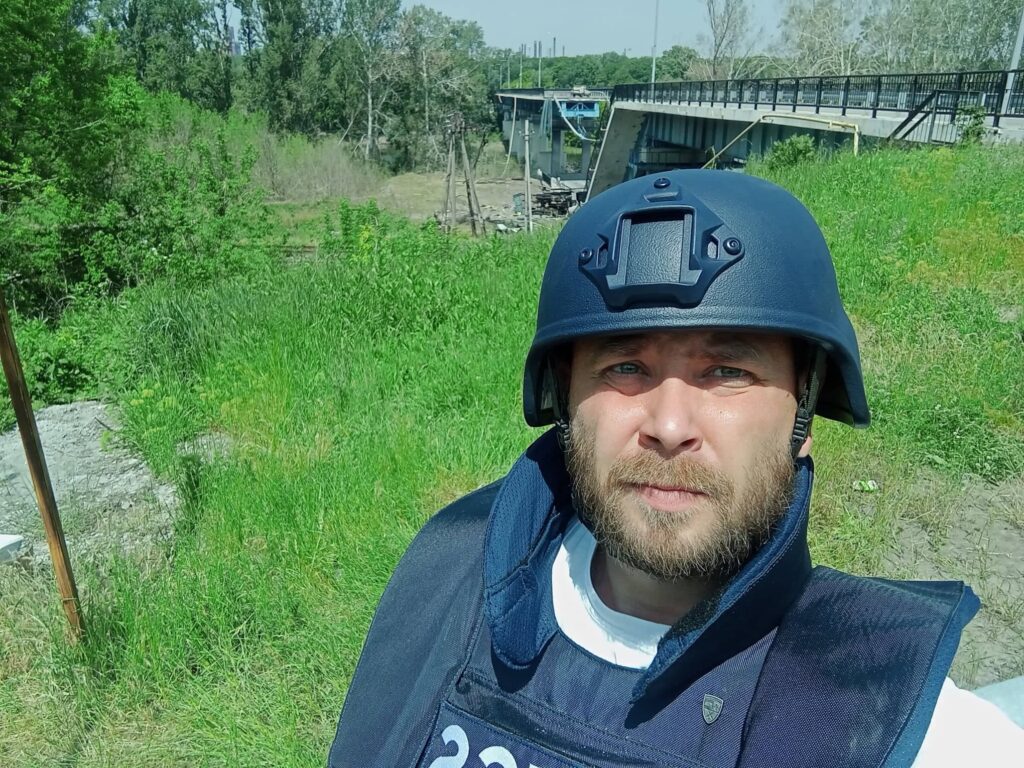
Serhiy says he considered it his duty to show: despite the war since 2014, a lot of things are built and done for the people of Ukraine.
“I considered it a personal challenge to show that something is done and money is invested here, in Ukraine, on a free territory. Because Ukraine understands that it is not only made up of political forces, political parties, ministries, departments, etc. Ukraine is, first of all, people. So, we wanted our stories to show how ordinary people lived and what was done for them first of all.”
One of Serhiy Okishev’s last stories before February 24, 2022 was filmed in Stanytsia Luhanska, when a kindergarten was shelled.
“We often went to Stanytsia. The last time was just a few days before February 22-24. Then the active phase began, as they called it, there was shelling and the Russians hit the kindergarten. Then a lot of media arrived, including foreign media – I counted about seven foreign media. The event received a lot of press coverage.”
The journalist recalls that at that time he had flashbacks from 2014.
“Then there really were flashbacks from 2014, when there was active shelling of Severodonetsk. At that time, my daughter was in the kindergarten basement, I was at work, and my wife was in the basement of the Khimtech office where she worked. On the next day after that incident in 2014, we left for Kharkiv, because that was very difficult to endure. So when I came to Stanytsia in February 2022 and saw that hole in the kindergarten, it was hard. I immediately thought of my own daughter.”
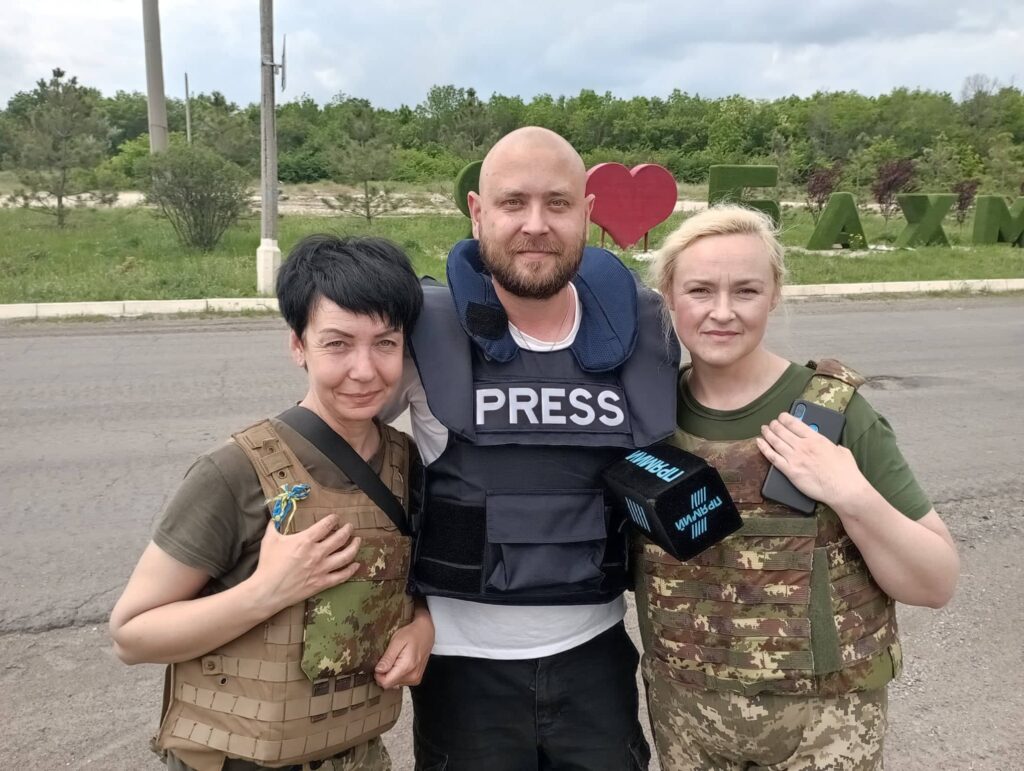
That morning started with explosions
“My February 24 began with the sounds of distant explosions. We started calling each other, colleagues, bosses, and relatives. Everyone had the same question: “What shall we do? What shall we do next?” On that very day, in the afternoon, the editorial staff of our local TV channel decided to meet at the editor-in-chief’s house and keep working. We did so for several weeks. We lived as a commune and worked. We stopped filming stories, and switched to informing local residents through Telegram channels, Facebook, and Instagram. We did it as long as it was necessary.”
Despite all that, Serhiy did not leave Severodonetsk immediately when the city began to be bombed. He says that his professional training played a bad joke on him.
“I stayed for a number of reasons. First of all, perhaps my training, the 2014 occupation and my experience at ground zero played a bad joke. I was sure until a certain time that nothing would happen to me or my family, because I was prepared. I could differentiate the enemy shooting from ours. We knew, we could tell by the sound where it hit. That is, when we should go down to the basement, and when can we stay in the apartment. And also, when you live like this for a long time, the sense of fear and reality dulls, it seems to you that everything is not so bad. You’re home; your family is with you. Another reason was that we could not leave our relatives, who were all in Severodonetsk. This is the older generation: my parents, my wife’s parents, our sisters and their families. And we decided to evacuate only as a group. That was yet another reason, as it isn’t easy for 10-15 people to leave at once,” says Serhiy.
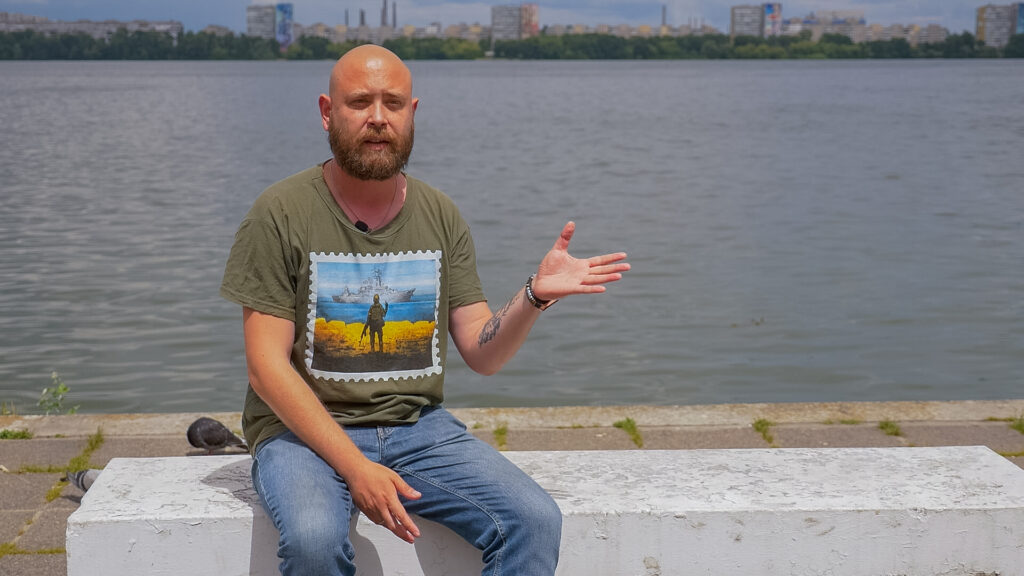
The day he survived
As of that fateful day, Serhiy and his family had been under constant shelling for about a month. The man says, back then they had still some hope that everything would soon end.
“I consider March 22, 2022 my second birthday because I stayed alive,” the journalist begins to recall that day.
He stood in line to buy food. At that time, he and his relatives were already moving from apartment to apartment in search of safer areas of the city.
“It was a line at a supermarket in Severodonetsk. At that time there were four of them operating in different parts of the city. And at that time, it was normal for about a hundred people to come to the store an hour before the opening time and stand in line to buy at least something. I was there with distant relatives and my former colleagues from Azot. We chatted, everything was fine. Then a man came up. He took pictures of the line from three or four sides, wrote something in a text messenger and left. And just a few minutes later, mortar shelling began.”
Serhiy miraculously survived that day.
The first two or three mines fell a few dozens of meters away from us. The line began to move towards the wall of the house. Suddenly I heard a whistle and a mine fell next to me. I only managed to shout “lie down”. I fell to the ground myself, covered my head with my hands, and felt pieces of asphalt falling on me, on my head, on my back. When I opened my eyes, there were a dozen wounded people. Their limbs, arms, legs were broken. There was a lot of blood. People were literally hanging on the fences because they could not stand on their feet. Their legs were just severed by rubble. I saw my relative, who was luckier. Her hands were cut, but the bones were intact; her face was mangled and covered in blood.”
His training as a military journalist worked – Serhiy found a nearby shelter and began taking wounded people there.
“I grabbed my relative and we ran to an open basement, about four meters from where it all happened. We started carrying people with more serious injuries there. We started applying tourniquets, bandaging them, cutting their clothes to free their limbs from dirty torn clothing. Then my relative said that her husband was with her, so we had to find him. I asked what clothes her husband was wearing. She said a blue jacket. I remember that when I took her to the basement, a lifeless man was lying on the ground. A dead body. He was severed into four parts in the blast. He had a blue jacket on. I left the basement, approached the body and began studying the dead man’s face, because at that moment it was necessary to recognize whether it was my relative or not. Luckily, thank God, it was not my relative’s husband. I found him later. Blood was coming out of his ears, eye, head, and it was obvious that he was severely injured. He had a very serious eye injury. So such was my experience – to look into the face of a dead man. Then, my two relatives were evacuated to Dnipro. They are still under a doctor’s care, because some pieces of shrapnel have stuck in his hands, head, eye. They have undergone several surgeries, but they are alive. After that, I decided to evacuate as soon as possible. We left the next day, March 23, and in just a few days we took all our relatives out of Severodonetsk.”
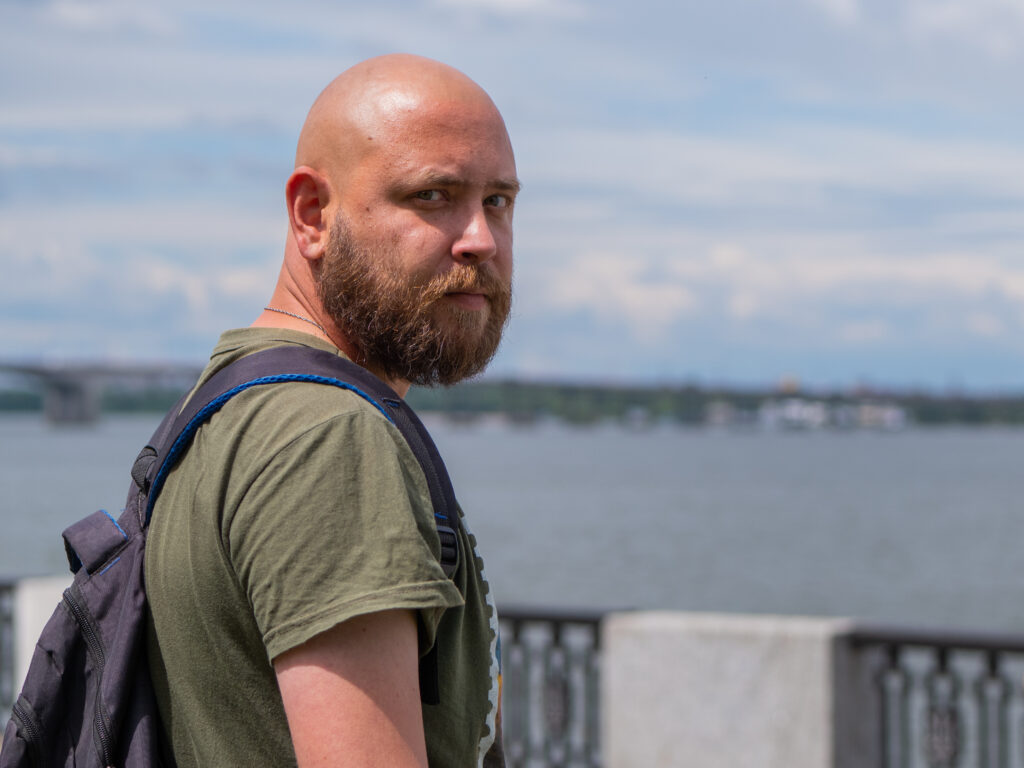
Life “from scratch” and work “at zero”
Like many other IDPs, the Okishev family spent the first night at their friends’ apartment in Novomoskovsk. It was there that the decision to evacuate was made.
“The next morning we went to look for an apartment. At that time, there were still vacant apartments in Novomoskovsk. We found one quickly, moved our stuff there, and started our new life in Novomoskovsk. It’s hard for me to remember the first days now, because we were all on the phones then, contacting our relatives, looking for options to evacuate everyone: the sisters’ families, their relatives and parents. When everyone was in Novomoskovsk, we heaved a sigh of relief. “
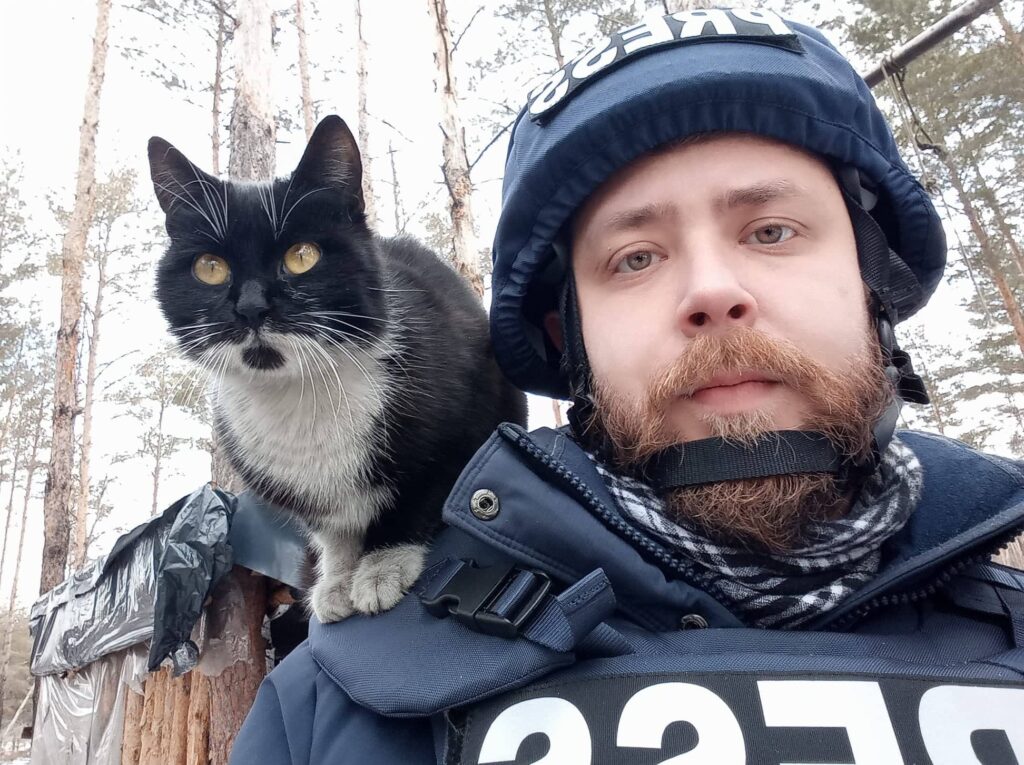
After they left, the question was how to find a job in a new city.
“When we started looking for a job, I don’t know whether it was karma or a boomerang effect. Apathy was over; my wife and I actively joined the volunteer movement in Novomoskovsk, we started helping other IDPs – and we found work quickly.”
Serhiy currently works as a war reporter at the Priamiy TV channel. He travels to Donetsk and Luhansk regions whenever it is possible and safe, and does war coverage.
“The work of a journalist at the front has two components. The first is spontaneous reports. That is, you wake up in the morning, watch the news feed and see that today they have shelled Bakhmut, Druzhkivka, Lysychansk. You get into a car, go to those places and film the consequences of the shelling. When you come to such places, you usually talk to people who have lost something as a result of the shelling. Usually those people are just like you. I was in the same situation. That is, you are at home, everything is fine with you, somewhere far away the sounds of shelling can be heard. But one bad morning it hits your yard, the neighboring house, and you understand that something must be done. Those people are usually confused and don’t know what to do next. And that’s why, in addition to doing your job as a journalist and reporter, you also try to explain to people, to give them some hope that their lives don’t stop.”
Serhiy says that he always tries to understand his characters and their feelings.
“Sometimes I had to tell people where it was better to leave for, where they could contact the right people to be provided with help immediately. Because, first of all, when you know, when you’ve been in that situation, it’s easier for you to understand those people and it’s easier to talk to them in the same language.”
The second component of the work of a war reporter, according to Serhiy, is planned filming.
“It poses far greater danger than operative filming. Because when you plan a filming, you know, for example, that you will go to Lysychansk at 9 a.m. today and have already agreed your trip with the police, military, and humanitarian headquarters. You have a great plan, what to shoot, who to talk to. And although it seems that you have calculated all the safety components, the devil is in the word “it seems.” The last time we were in Lysychansk, the filming was supposed to take place according to this scenario. We went there accompanied by the police and another film crew. Two more film crews, accompanied by policemen, followed us with a difference of 10-15 minutes. We were not one convoy. That is, we did not expose ourselves to danger, as it seemed to us at that moment. We arrived, everything was filmed and then another car that was following us arrived. It was an armored car with a huge hole in the windshield and a dead French journalist in it.”
At that moment, the man says, he was working on adrenaline.
“At such a moment, you don’t think about whether it’s scary or disgusting – you don’t think about it at all. You see it and you try to do something about it. My colleague and I tried to pull the deceased out of the car. When there is real danger, I don’t know about other people, but I do everything automatically. I hear shooting somewhere nearby – I either fall to the ground or run to a shelter. I see a wounded person – I stop the bleeding. When I see a dead person, I try to put him somewhere so that at least the body remains intact and does not come under another shelling. Here you see-do-have done. But when you become aware of it in the evening, it is quite difficult. For me, this means at least one sleepless night.”
However, Serhiy Okishev has not put his home, his Severodonetsk behind him yet. But he doubts that he will return to live there after the victory – the city is too badly destroyed.
“I haven’t said goodbye to it yet. I am waiting for Severodonetsk to be recaptured from ruscists, or them to be pushed back from the town to a distance of at least 15 kilometers. Then I’ll return to Severodonetsk to make a news report and then I’ll probably say a final goodbye to it.”
Maryna Tereshchenko, Luhansk-Severodonetsk-Dnipro
27.06.2022
Article is prepared within the project “Countering Disinformation in Southern and Eastern Ukraine” funded by the European Union.

